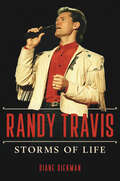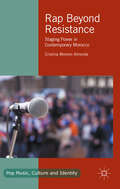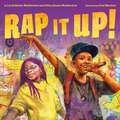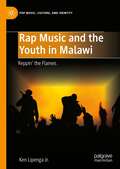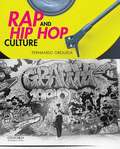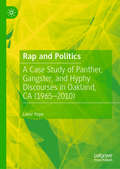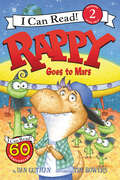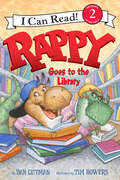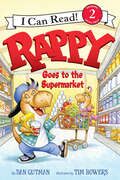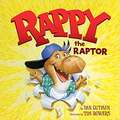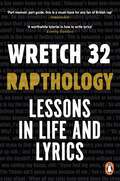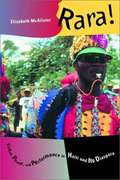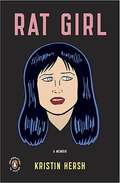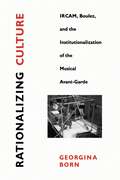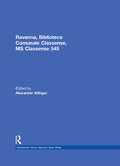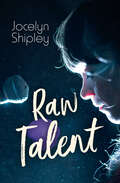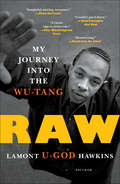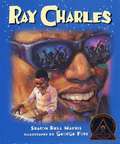- Table View
- List View
Randy Travis: Storms of Life (Music in American Life)
by Diane DiekmanRandy Travis’s 1986 breakthrough put him at the forefront of Nashville’s new traditionalist sound and, in the words of Garth Brooks, saved country music. The singer’s warm baritone and all-time classic songs like “Forever and Ever, Amen” landed him atop the charts sixteen times. His cross-genre appeal brought a level of multiplatinum success that no country artist before him had ever achieved. Diane Diekman’s biography follows the life and career of one of country music’s most beloved figures. Steered from a troubled path as a teen, Travis served a long apprenticeship under manager and future wife Lib Hatcher before being rejected by the Nashville music industry as “too country.” The single “On the Other Hand” and his smash debut album did away with the doubters and began a dominant four-year run that stretched into ongoing success as a recording artist, trailblazing live performer, and actor in film and television. Diekman uses dozens of interviews and in-depth research to fill in the details of Travis’s pre-fame life and his enormous impact on country, popular, and gospel music. From there, she pivots to telling the story of the singer’s difficult divorce from Hatcher, subsequent problems with alcohol and run-ins with the law, and the challenges he overcame in the aftermath of a devastating 2013 stroke. Informed by a wealth of new research and interviews, Randy Travis is the first in-depth biography of the country music legend.
Rap Beyond Resistance
by Cristina Moreno AlmeidaThis book fills the gap in existing literature by exploring other forms of political discourses in non-Western rap music. Theoretically, it challenges and explores resistance, arguing towards the need for different epistemological frameworks in which to look at narratives of cultural resistance in the Arabic-speaking world. Empirically, it provides an in-depth look at the politics of rap culture in Morocco. Rap Beyond Resistance bridges the humanities and social sciences in order to de-Westernize cultural studies, presenting the political narratives of the Moroccan rap scene beyond secular liberal meanings of resistance. By exploring what is political, this book brings light to a vibrant and varied rap scene diverse in its political discourses - with an emphasis on patriotism and postcolonial national identity - and uncovers different ways in which young artists are being political beyond 'radical lyrics'.
Rap Capital: An Atlanta Story
by Joe CoscarelliAn &“impassioned tribute&” (Publishers Weekly, starred review) to the most influential music culture today, Atlanta rap—a masterful, street-level story of art, money, race, class, and salvation from acclaimed New York Times reporter Joe Coscarelli.From mansions to trap houses, office buildings to strip clubs, Atlanta is defined by its rap music. But this flashy and fast-paced world is rarely seen below surface level as a collection not of superheroes and villains, cartoons and caricatures, but of flawed and inspired individuals all trying to get a piece of what everyone else seems to have. In artistic, commercial, and human terms, Atlanta rap represents the most consequential musical ecosystem of this century. Rap Capital tells the dramatic stories of the people who make it tick and the city that made them that way. The lives of the artists driving the culture, from megastars like Lil Baby and Migos to lesser-known local strivers like Lil Reek and Marlo, represent the modern American dream but also an American nightmare, as young Black men and women wrestle generational curses, crippled school systems, incarceration, and racism on the way to an improbably destination atop art and commerce. Across Atlanta, rap dreams power countless overlapping economies, but they&’re also a gamble, one that could make a poor man rich or a poor man poorer, land someone in jail or keep them out of it. Drawing on years of reporting, more than a hundred interviews, dozens of hours in recording studios and on immersive ride-alongs, acclaimed New York Times reporter Joe Coscarelli weaves a cinematic tapestry of this singular American culture as it took over in the last decade, from the big names to the lesser-seen prospects, managers, grunt-workers, mothers, DJs, lawyers, and dealers that are equally important to the industry. The result is a deeply human, era-defining book that is &“required reading for anyone who has ever wondered how, exactly, Atlanta hip-hop took over the world&” (Kelefa Sanneh, author of Major Labels). Entertaining and profound, Rap Capital is an epic of art, money, race, class, and sometimes, salvation.
Rap Dad: A Story of Family and the Subculture That Shaped a Generation
by Juan VidalA timely reflection on identity in America, exploring the intersection of fatherhood, race, and hip-hop culture.Just as his music career was taking off, Juan Vidal received life-changing news: he’d soon be a father. Throughout his life, neglectful men were the rule—his own dad struggled with drug addiction and infidelity—a cycle that, inevitably, wrought Vidal with insecurity. At age twenty-six, with only a bare grip on life, what lessons could he possibly offer a kid? Determined to alter the course for his child, Vidal did what he’d always done when confronted with life’s challenges. He turned to the counterculture. “The counterculture took the place of a father I could no longer touch. Since things like school and church couldn’t get through to me, I was being trained up outside of organized institutions. What I gravitated to were these movements that not only felt redeeming, but also freeing. They were almost everything I needed.” In Rap Dad, the musician-turned-journalist takes a thoughtful and inventive approach to exploring identity and examining how we view fatherhood in a modern context. To root out the source of his fears around parenting, Vidal revisits the flash points of his juvenescence, a feat that transports him, a first-generation American born to Colombian parents, back to the drug-fueled streets of 1980s–90s Miami. It’s during those pivotal years that he’s drawn to skateboarding, graffiti, and the music of rebellion: hip-hop. As he looks to the past for answers, he infuses his personal story with rap lyrics and interviews with some of pop culture’s most compelling voices—plenty of whom have proven to be some of society’s best, albeit nontraditional, dads. Along the way, Vidal confronts the unfair stereotypes that taint urban men—especially Black and Latino men—in today’s society. An illuminating journey of discovery, Rap Dad is a striking portrait of modern fatherhood that is as much political as it is entertaining, personal as it is representative, and challenging as it is revealing.
Rap It Up!
by Carole Boston Weatherford Jeffery Boston WeatherfordAspiring young rappers will delight in this infectious, read-aloud introduction to the poetry and craft of rap.From scribbling words on the page to spitting rhymes on the mic, a joyful narrator guides readers through the emotions, literary techniques, structures and motifs that help make rap so amazing. With vibrant illustrations that leap off the page, this book urges readers to believe in themselves and the power of their creativity.Celebratory and informative, Rap it Up! invites us to see where our imaginations may lead. Get ready to drop some beats, express yourself, and let the world hear what you've got to say!
Rap Music and the Youth in Malawi: Reppin' the Flames (Pop Music, Culture and Identity)
by Ken Lipenga Jr.Rap Music and the Youth in Malawi is one of the first book-length studies of Malawian hip hop. It studies the language and content of contemporary Malawian hip hop as a window onto the country's youth culture as Malawian young people negotiate what scholar Alcinda Honwana calls 'waithood,' or the condition, common among Malawian youth, of lacking opportunities to advance from a situation of dependence and being stuck in a state of relative childhood. The book argues that rap music made by Malawian youth music speaks of – and represents, through its very agency – their need to break out of this stagnant state. After situating Malawian hip hop with respect to both other musical genres in the country and to the nation's language in culture, Rap Music and the Youth in Malawi shows how Malawian youth use rap music to create a sense of community, which then becomes a foothold from which they can do activities that get them out of waithood and into the adult world, such as getting involved in the music industry, realizing electoral power, or participating in activism about issues such as violence against people with albinism and the COVID-19 pandemic. Hip hop has been a crucial tool for Malawian youth to build the skills, identity, and agency necessary to exercise their economic, cultural, and civic independence.
Rap and Hip Hop Culture
by Fernando OrejuelaRap and Hip Hop Culture traces the ideological, social, historical, and cultural influences on a musical genre that first came to prominence in the mid-1970s in one of New York's toughest neighborhoods, the South Bronx. Orejuela describes how the arts of DJing, MCing, breakin' [b-boying], and graffiti developed as a way for this community's struggle to find its own voice. He addresses rap's early successes on the pop charts; its spread to mainstream culture; the growth of "gangsta rap" and mainstream society's reaction to it; and the commercial success of rap music from the '90s through today. Throughout, this enlightening text highlights key performers, producers, and voices in the rap and hip hop movements, using their stories to illuminate the underlying issues of racism, poverty, prejudice, and artistic freedom that are part of rap and hip hop's ongoing legacy.
Rap and Politics: A Case Study of Panther, Gangster, and Hyphy Discourses in Oakland, CA (1965-2010)
by Lavar PopeRap and Politics maps out fifty years of political and musical development by exploring three specific moments of local discourse, each a response to failures by local, state, and national governments to address police brutality, violence, poverty, and poor social conditions in Oakland, California and the surrounding Bay Area. First, in the mid-1960s, Black youth responded to repressive political and socioeconomic factors in West Oakland by founding the Black Panther Party for Self Defense, whose representation of violence and community aid, as well as its radical and militant approach to Black Nationalism, became a foundational discourse that shaped the development of rap music in the region. Second, from the collapse of the Party in the early 1980s through the 1990s, gangster rap emerged as a form of political expression among local youth, who drew heavily on radical and militant elements of Panther discourse in their lyrics and artwork. Third, hyphy music in the mid-1990s to early 2000s continued these radical discourses and also incorporated coordinated, subversive public behavior to the mix. The result was a critique of endemic problems facing the local Black community, but also an infectious subgenre of party music that gained mainstream popularity. Overall, this study shows that the specific types of representation created to resist problems of racism and poverty in Oakland is actually key to understanding other rap undergrounds, grassroots subcultures, and social movements elsewhere. In the process, Rap and Politics offers readers a new model focused on the development of settings, representation, movements, discourse banks, and impact within underground rap scenes.
Rap-Up: The Ultimate Guide to Hip-Hop and R&B
by Devin Lazerine Cameron LazerineIn this fun, edgy, and essential guide, the editors of today's hottest music magazine give you the ultimate, all-access pass to the exciting world of hip-hop and contemporary R&B. From the megaselling songs to the biggest stars to the most outrageous scandals, RAP-UP gives you a comprehensive behind-the-scenes look at the revolutionary music that's transforming pop culture. Discover: HISTORY LESSON How it all started, from rappers armed with toy keyboards and ambition...to breakout groups like Run-D.M.C. and Public Enemy who brought the 'hood to the suburbs and changed music forever. THE NEW NEW SCHOOL One-of-a-kind profiles of Jay-Z, Beyoncé, 50 Cent, Usher, Ciara, and all the hottest artists. And a look at the moguls and producers who shape the hits, including urban-flow stylist Jermaine Dupri, off-center innovators The Neptunes, and techno-beat genius Timbaland. WHERE'S THE BEEF? The inside story on rap's most notorious battles, from the legendary Juice Crew vs. Boogie Down Productions duel over hip-hop bragging rights, to the Jay-Z vs. Nas battle-of-the-giants, to the 50 Cent vs. The Game take-no-prisoners faceoff. FROM HOLLIS TO HOLLYWOOD A comprehensive list of hip-hop on the silver screen-the good, the bad, and the performers (Will Smith, Jamie Foxx, Queen Latifah) who achieved box office gold and Oscar fame. Complete with takes on must-own CDs and tracks, pop quizzes, career highlights, and artist road maps, this unique, definitive book is all you need to get down with everything hip-hop and R&B.
Rapping for Kids: Corey's Story (Fountas & Pinnell Classroom, Guided Reading Grade 4)
by Anderson Mehta Deborah ThorntonNIMAC-sourced textbook
Rappy Goes to Mars (I Can Read Level 2)
by Dan GutmanOne day at recess, Rappy the dinosaur gets taken by aliens on a U.F.O. ride. The head alien, Janet, wants Rappy to live with her—on Mars! Will Rappy stay in space to roam, or will he rap his way back home?Beginning readers will love rapping along as Rappy goes on an out-of-this-world adventure. This rhyming Level Two I Can Read is geared for kids who read on their own but still need a little help.
Rappy Goes to the Library (I Can Read Level 2)
by Dan GutmanWhen Rappy the Raptor’s class goes to the library, it’s all Rappy can do not to be noisy. Can he keep his rapping quiet, or will he start a book riot? When students are finding the library a bore, quick-thinking Rappy uses his rhyming skills to save the day!Beginning readers will love to rap along as Rappy learns what a fun place the library can be. This rhyming Level Two I Can Read is perfect for for kids who read on their own but still need a little help.Take a look at all these books!Books that are fiction!Books that are facts!Books that help you to relax!
Rappy Goes to the Supermarket (I Can Read Level 2)
by Dan GutmanRappy the Raptor is going to the grocery store. What a bore! But Rappy finds himself actually having fun…that is, until he tips over a HUGE display of toilet paper rolls. The manager is angry, but the quick-thinking Rappy uses his rhyming skills to save the day!Beginning readers will enjoy rapping through the supermarket aisles with everyone’s favorite raptor. Rappy knows how to make even a trip to the supermarket fun! This rhyming Level Two I Can Read is perfect for beginning and developing readers.Where are you taking me?I really want to know.Why are you making me?I don’t want to go!
Rappy the Raptor
by Dan GutmanMeet Rappy the Raptor, a velociraptor who speaks in rhymes all of the time, whether it's morning or noon, October or June. Now, how did it happen that he started rappin'? Well, here's Rappy's story in all its glory! <P><P>New York Times bestselling author Dan Gutman and New York Times bestselling artist Tim Bowers team up for a funny, warm story that is sure to have readers snapping their fingers and tapping their toes! Parents and kids alike will love bopping along as Rappy learns to embrace his unusual way of speaking in this upbeat picture book with a dino-size beat.
Rapsodia Española and Other Piano Works
by Isaac AlbenizThis compilation of Isaac Albéniz's piano gems features brilliant keyboard music steeped in the lyric and rhythmic spirit of Spain. Although he wrote operas with English words as well as songs and orchestral music, the composer was a leading figure in the development of Spain's national style of composition. Albéniz incorporated elements of traditional Spanish folk music into his works, drawing upon the Iberian Peninsula's diverse array of folk dances for creations of rhythmic exuberance.Albéniz is most widely recognized for his piano music, and this compilation encompasses the spirited pieces that reflect his most popular style. Contents include Suite Española, Les saisons,Rapsodia española and Rapsodia cubana, Mallorca, Zortzico ("Basque Dance"), Troisième Suite Ancienne ("Minuetto" and "Gavotta"); and the brilliant La Vega.
Rapthology: Lessons in Life and Lyrics
by Jermaine Scott 32'Groundbreaking... Part memoir, part guide, this is a must-have.' Independent'A worthwhile tutorial.' Evening Standard"Poetry and rap come from the same family. They're brothers. Just because you're good at one doesn't necessarily mean you'll be good at the other, but if you master both you'll be unparalleled."Rapthology is a masterclass in lyric writing. A spotlight into the craft and skill of what it takes to be an incredible artist by pioneering musician and artist, Wretch 32. Taking us through the songs which have shaped his career over the last two decades step by step, explaining what each song means to him, his own creative process, from the first flashes of inspiration to final edits and improvisation, right through to how popular and powerful his lyrics are.Part autobiography, part guide to creativity and part cultural history Rapthology is a blueprint to the music that matters.
Rara! Vodou, Power, and Performance in Haiti and Its Diaspora
by Elizabeth A. McalisterThis book is the first full-length study of the religious music festival known as Rara as it is traditionally practiced in Haiti and Brooklyn. A centuries-old religious tradition with roots in plantation slavery, this community-produced music grows out of Afro-Haitian voodoo and is frequently used to launch political criticism.
Rat Girl
by Kristin HershThe founder of a cult rock band shares her outrageous tale of growing up much faster than planned. In 1985, Kristin Hersh was just starting to find her place in the world. After leaving home at the age of fifteen, the precocious child of unconventional hippies had enrolled in college while her band, Throwing Muses, was getting off the ground amid rumors of a major label deal. Then everything changed: she was diagnosed with bipolar disorder and found herself in an emotional tailspin; she started medication, but then discovered she was pregnant. An intensely personal and moving account of that pivotal year, Rat Girl is sure to be greeted eagerly by Hersh's many fans.
Rationalizing Culture: IRCAM, Boulez, and the Institutionalization of the Musical Avant-Garde
by Georgina BornAnthropologist Georgina Born presents one of the first ethnographies of a powerful western cultural organization, the renowned Institut de Recherche et de Coordination Acoustique/Musique (IRCAM) in Paris. As a year-long participant-observer, Born studied the social and cultural economy of an institution for research and production of avant-garde and computer music. She gives a unique portrait of IRCAM's composers, computer scientists, technicians, and secretaries, interrogating the effects of the cultural philosophy of the controversial avant-garde composer, Pierre Boulez, who directed the institute until 1992.Born depicts a major artistic institution trying to maintain its status and legitimacy in an era increasingly dominated by market forces, and in a volatile political and cultural climate. She illuminates the erosion of the legitimacy of art and science in the face of growing commercial and political pressures. By tracing how IRCAM has tried to accomodate these pressures while preserving its autonomy, Born reveals the contradictory effects of institutionalizing an avant-garde.Contrary to those who see postmodernism representing an accord between high and popular culture, Born stresses the continuities between modernism and postmodernism and how postmodernism itself embodies an implicit antagonism toward popular culture.
Rave On: Global Adventures in Electronic Dance Music
by Matthew CollinPeace, Love, Unity, and Respect. Cultural liberation and musical innovation. Pyrotechnics, bottle service, bass drops, and molly. Electronic dance music has been a vital force for more than three decades now, and has undergone transformation upon transformation as it has taken over the world. In this searching, lyrical account of dance music culture worldwide, Matthew Collin takes stock of its highest highs and lowest lows across its global trajectory. Through firsthand reportage and interviews with clubbers and DJs, Collin documents the itinerant musical form from its underground beginnings in New York, Chicago, and Detroit in the 1980s, to its explosions in Ibiza and Berlin, to today’s mainstream music scenes in new frontiers like Las Vegas, Shanghai, and Dubai. Collin shows how its dizzying array of genres—from house, techno, and garage to drum and bass, dubstep, and psytrance—have given voice to locally specific struggles. For so many people in so many different places, electronic dance music has been caught up in the search for free cultural space: forming the soundtrack to liberation for South African youth after Apartheid; inspiring a psychedelic party culture in Israel; offering fleeting escape from—and at times into—corporatization in China; and even undergirding a veritable “independent republic” in a politically contested slice of the former Soviet Union. Full of admiration for the possibilities the music has opened up all over the world, Collin also unflinchingly probes where this utopianism has fallen short, whether the culture maintains its liberating possibilities today, and where it might go in the future.
Ravenna, Biblioteca Comunale Classense, MS Classense 545 (Seventeenth Century Keyboard Music Series #12)
by Alexander SilbigerFirst Published in 1988. Routledge is an imprint of Taylor & Francis, an informa company.
Raver Girl: Coming of Age in the 90s
by Samantha DurbinA PopSugar Best New Books of 2021 Selection Weed inspires her. Acid shows her another dimension. Ecstasy releases her. Nitrous fills her with bliss. Cocaine makes her fabulous. Mushrooms make everything magical. Special K numbs her. Crystal meth makes her mean. Sixteen-year-old Samantha, raver extraordinaire, puts the “high” in high school. A ’90s time capsule buried inside a coming-of-age memoir set against the neon backdrop of the San Francisco Bay Area's rave scene, Raver Girl chronicles Samantha’s double life as she teeters between hedonism and sobriety, chaos and calm, all while sneaking under the radar of her entrepreneur father—a man who happened to drop acid with LSD impresario Owsley Stanley in the ’60s. Samantha keeps a list of every rave she goes to—a total of 104 over four years. During that time, what started as trippy fun morphs into a self-destructive roller coaster ride. Samantha opens the doors of her mind, but she's left with traumas her acid-fried brain won't let her escape; and when meth becomes her drug of choice, things get progressively darker. Through euphoric highs and dangerous lows, Samantha discovers she’s someone who lives life to the fullest and learns best through alternative experience rather than mainstream ideals. She’s a creative whose mind is limitless, whose quirks are charms, whose passion is inspirational. She’s an independent woman whose inner strength is rooted in unwavering family ties. And if she can survive high school, she just might be okay.
Raw Talent (Orca Limelights)
by Jocelyn ShipleyFourteen-year-old Paisley loves to sing. Paisley dreams of being a pop star just like her idol, Denzi, who also grew up in the small town of Stonehill. The problem is, Paisley suffers from severe stage fright. She can only sing in private. When word gets out that a famous Stratford actor who has worked with Denzi is staying at a local B&B, Paisley decides it's time to face her fears. She convinces the actor to tutor her and signs up to sing in a high-profile fundraiser. This short novel is a high-interest, low-reading level book for middle-grade readers who are building reading skills, want a quick read or say they don’t like to read!
Raw: My Journey into the Wu-Tang
by Lamont "U-God" HawkinsA PERFECT COMPANION READ TO THE SHOWTIME DOCUMENTARY, WU-TANG CLAN: OF MICS AND MENSelected as a Best Book of the Year by Esquire"Couldn't put it down." – Charlamagne Tha God"Mesmerizing." – Raekwon da Chef"Insightful, moving, necessary." – Shea Serrano"Cathartic." –The New Yorker"A classic." –The Washington PostThe explosive, never-before-told story behind the historicrise of the Wu-Tang Clan, as told by one of its founding members, Lamont "U-God" Hawkins.“It’s time to write down not only my legacy, but the story of nine dirt-bomb street thugs who took our everyday life—scrappin’ and hustlin’and tryin’ to survive in the urban jungle of New York City—and turned that into something bigger than we could possibly imagine, something that took us out of the projects for good, which was the only thing we all wanted in the first place.” —Lamont "U-God" HawkinsThe Wu-Tang Clan are considered hip-hop royalty. Remarkably, none of the founding members have told their story—until now. Here, for the first time, the quiet one speaks. Lamont “U-God” Hawkins was born in Brownsville, New York, in 1970. Raised by a single mother and forced to reckon with the hostile conditions of project life, U-God learned from an early age how to survive. And surviving in New York City in the 1970s and 1980s was no easy task—especially as a young black boy living in some of the city’s most ignored and destitute districts. But, along the way, he met and befriended those who would eventually form the Clan’s core: RZA, GZA, Method Man, Raekwon, Ol’ Dirty Bastard, Inspectah Deck, Ghostface Killah, and Masta Killa. Brought up by the streets, and bonding over their love of hip-hop, they sought to pursue the impossible: music as their ticket out of the ghetto.U-God’s unforgettable first-person account of his journey,from the streets of Brooklyn to some of the biggest stages around the world, is not only thoroughly affecting, unfiltered, and explosive but also captures, invivid detail, the making of one of the greatest acts in American music history.
Ray Charles
by Sharon Bell Mathis George FordIn a beautiful new edition of this 1973 multiple award-winning biography, young readers learn the rags-to-riches story of legendary musician Ray Charles's life - from age 7, when he loses his sight completely, to age 40, when he performs to dazzled audiences world-wide and participates in the fight for racial justice. A new introduction by the author sets the context for Charles's journey to stardom, and an afterword updates his life to the present.<P><P>Winner of the Coretta Scott King Medal
